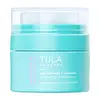What's inside
What's inside
 Key Ingredients
Key Ingredients

 Benefits
Benefits

 Concerns
Concerns

 Ingredients Side-by-side
Ingredients Side-by-side

Cyclopentasiloxane
EmollientWater
Skin ConditioningIsostearyl Palmitate
EmollientPolyethylene
AbrasiveButylene Glycol
HumectantPolysilicone-11
Ethylene/Acrylic Acid Copolymer
Emulsion StabilisingMorus Bombycis Root Extract
Skin ConditioningCaffeine
Skin ConditioningPhytosphingosine
Skin ConditioningTriticum Vulgare Bran Extract
Skin ConditioningScutellaria Baicalensis Root Extract
AstringentLactis Proteinum
Skin ConditioningOlea Europaea Fruit Extract
BleachingCamellia Sinensis Leaf Extract
AntimicrobialCholesterol
EmollientLinoleic Acid
CleansingTocopheryl Acetate
AntioxidantMagnesium Ascorbyl Phosphate
AntioxidantPyridoxine Dipalmitate
Skin ConditioningSucrose
HumectantGlycerin
HumectantDimethicone
EmollientGlyceryl Laurate
EmollientPEG/PPG-18/18 Dimethicone
EmulsifyingPetrolatum
EmollientCetyl PEG/PPG-10/1 Dimethicone
EmulsifyingPropylene Carbonate
SolventSodium Chloride
MaskingQuaternium-90 Bentonite
Disodium EDTA
Phenoxyethanol
PreservativeIron Oxides
Cyclopentasiloxane, Water, Isostearyl Palmitate, Polyethylene, Butylene Glycol, Polysilicone-11, Ethylene/Acrylic Acid Copolymer, Morus Bombycis Root Extract, Caffeine, Phytosphingosine, Triticum Vulgare Bran Extract, Scutellaria Baicalensis Root Extract, Lactis Proteinum, Olea Europaea Fruit Extract, Camellia Sinensis Leaf Extract, Cholesterol, Linoleic Acid, Tocopheryl Acetate, Magnesium Ascorbyl Phosphate, Pyridoxine Dipalmitate, Sucrose, Glycerin, Dimethicone, Glyceryl Laurate, PEG/PPG-18/18 Dimethicone, Petrolatum, Cetyl PEG/PPG-10/1 Dimethicone, Propylene Carbonate, Sodium Chloride, Quaternium-90 Bentonite, Disodium EDTA, Phenoxyethanol, Iron Oxides
Water
Skin ConditioningButyrospermum Parkii Butter
Skin ConditioningGlycerin
HumectantSqualane
EmollientIsopentyldiol
HumectantMyristyl Myristate
EmollientButylene Glycol
Humectant1,2-Hexanediol
Skin ConditioningPentaerythrityl Tetraisostearate
EmollientLactococcus Ferment Lysate
Skin ConditioningArachidyl Alcohol
EmollientCetearyl Olivate
Glyceryl Stearate
EmollientOenothera Biennis Oil
EmollientPseudozyma Epicola/Camellia Sinensis Seed Oil Ferment Extract Filtrate
HumectantBakuchiol
AntimicrobialRetinal
Skin ConditioningLactobacillus
Skin ConditioningLactobacillus Ferment
Skin ConditioningHaematococcus Pluvialis Extract
AntioxidantBeta Vulgaris Root Extract
Skin ConditioningCurcuma Longa Root Extract
MaskingRosmarinus Officinalis Leaf Extract
AntimicrobialPalmitoyl Tetrapeptide-7
Skin ConditioningInulin
Skin ConditioningAlpha-Glucan Oligosaccharide
CleansingCeramide NP
Skin ConditioningLactic Acid
BufferingCeramide AP
Skin ConditioningCeramide As
Skin ConditioningCeramide Ns
Skin ConditioningChrysin
Skin ConditioningCeramide EOP
Skin ConditioningChamomilla Recutita Flower Extract
MaskingCholesterol
EmollientSqualene
EmollientBehenyl Alcohol
EmollientSorbitan Olivate
EmulsifyingSodium Polyacryloyldimethyl Taurate
Emulsion StabilisingArachidyl Glucoside
EmulsifyingSodium Polyacrylate Starch
AbsorbentSodium Polyglutamate
HumectantPhosphatidylcholine
EmulsifyingPentylene Glycol
Skin ConditioningSodium Dilauramidoglutamide Lysine
Humectant2,3-Butanediol
HumectantPolymnia Sonchifolia Root Juice
Skin ConditioningHydrogenated Lecithin
EmulsifyingMaltodextrin
AbsorbentSodium Benzoate
MaskingCitric Acid
BufferingTocopherol
AntioxidantPhytic Acid
Potassium Sorbate
PreservativeSodium Chloride
MaskingBeta-Sitosterol
Emulsion StabilisingCalcium Alginate
MaskingCaprylyl Glycol
EmollientLecithin
EmollientPropanediol
SolventSodium Hydroxide
BufferingXanthan Gum
EmulsifyingWater, Butyrospermum Parkii Butter, Glycerin, Squalane, Isopentyldiol, Myristyl Myristate, Butylene Glycol, 1,2-Hexanediol, Pentaerythrityl Tetraisostearate, Lactococcus Ferment Lysate, Arachidyl Alcohol, Cetearyl Olivate, Glyceryl Stearate, Oenothera Biennis Oil, Pseudozyma Epicola/Camellia Sinensis Seed Oil Ferment Extract Filtrate, Bakuchiol, Retinal, Lactobacillus, Lactobacillus Ferment, Haematococcus Pluvialis Extract, Beta Vulgaris Root Extract, Curcuma Longa Root Extract, Rosmarinus Officinalis Leaf Extract, Palmitoyl Tetrapeptide-7, Inulin, Alpha-Glucan Oligosaccharide, Ceramide NP, Lactic Acid, Ceramide AP, Ceramide As, Ceramide Ns, Chrysin, Ceramide EOP, Chamomilla Recutita Flower Extract, Cholesterol, Squalene, Behenyl Alcohol, Sorbitan Olivate, Sodium Polyacryloyldimethyl Taurate, Arachidyl Glucoside, Sodium Polyacrylate Starch, Sodium Polyglutamate, Phosphatidylcholine, Pentylene Glycol, Sodium Dilauramidoglutamide Lysine, 2,3-Butanediol, Polymnia Sonchifolia Root Juice, Hydrogenated Lecithin, Maltodextrin, Sodium Benzoate, Citric Acid, Tocopherol, Phytic Acid, Potassium Sorbate, Sodium Chloride, Beta-Sitosterol, Calcium Alginate, Caprylyl Glycol, Lecithin, Propanediol, Sodium Hydroxide, Xanthan Gum
 Reviews
Reviews

Ingredients Explained
These ingredients are found in both products.
Ingredients higher up in an ingredient list are typically present in a larger amount.
Butylene Glycol (or BG) is used within cosmetic products for a few different reasons:
Overall, Butylene Glycol is a safe and well-rounded ingredient that works well with other ingredients.
Though this ingredient works well with most skin types, some people with sensitive skin may experience a reaction such as allergic rashes, closed comedones, or itchiness.
Learn more about Butylene GlycolCholesterol is a class of organic molecules called lipids. It helps hydrate your skin and is essential to having a healthy skin barrier.
Our skin naturally contains cholesterol in the outermost layer. Besides cholesterol, it also contains ceramides and fatty acids. Cholesterol makes up about 1/4 of your skin's outer layer and barrier. Your skin barrier is responsible for keeping allergens and microbes out. Having a healthy skin barrier is also responsible for keeping your skin firm and plump.
Our bodies use cholestrol to create vitamin D, steroid hormones, and more.
Learn more about CholesterolGlycerin is already naturally found in your skin. It helps moisturize and protect your skin.
A study from 2016 found glycerin to be more effective as a humectant than AHAs and hyaluronic acid.
As a humectant, it helps the skin stay hydrated by pulling moisture to your skin. The low molecular weight of glycerin allows it to pull moisture into the deeper layers of your skin.
Hydrated skin improves your skin barrier; Your skin barrier helps protect against irritants and bacteria.
Glycerin has also been found to have antimicrobial and antiviral properties. Due to these properties, glycerin is often used in wound and burn treatments.
In cosmetics, glycerin is usually derived from plants such as soybean or palm. However, it can also be sourced from animals, such as tallow or animal fat.
This ingredient is organic, colorless, odorless, and non-toxic.
Glycerin is the name for this ingredient in American English. British English uses Glycerol/Glycerine.
Learn more about GlycerinChances are, you eat sodium chloride every day. Sodium Chloride is also known as table salt.
This ingredient has many purposes in skincare: thickener, emulsifier, and exfoliator.
You'll most likely find this ingredient in cleansers where it is used to create a gel-like texture. As an emulsifier, it also prevents ingredients from separating.
There is much debate on whether this ingredient is comedogenic. The short answer - comedogenic ratings don't tell the whole story. Learn more about comegodenic ratings here.
The concensus about this ingredient causing acne seems to be divided. Research is needed to understand if this ingredient does cause acne.
Scrubs may use salt as the primary exfoliating ingredient.
Learn more about Sodium ChlorideWater. It's the most common cosmetic ingredient of all. You'll usually see it at the top of ingredient lists, meaning that it makes up the largest part of the product.
So why is it so popular? Water most often acts as a solvent - this means that it helps dissolve other ingredients into the formulation.
You'll also recognize water as that liquid we all need to stay alive. If you see this, drink a glass of water. Stay hydrated!
Learn more about Water